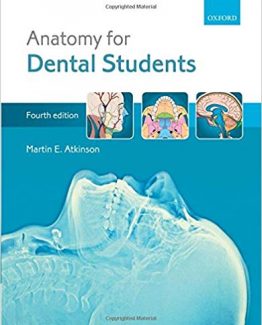Principles of Cognitive Neuroscience 2nd Edition by Dale Purves, ISBN-13: 978-0878935734
[PDF eBook eTextbook]
- Publisher: Sinauer Associates is an imprint of Oxford University Press; 2nd edition (November 1, 2012)
- Language: English
- 601 pages
- ISBN-10: 0878935738
- ISBN-13: 978-0878935734
The new and rapidly evolving field of cognitive neuroscience brings together cognitive psychology and neuroscience, drawing conceptual and technical elements from both these traditional disciplines. This union has been motivated by the exciting possibility of better understanding complex human brain functions that have puzzled thinkers for centuries. The emergence of cognitive neuroscience as a discipline in its own right over the last two decades is thus an expression of what many see as the next logical step for both neuroscience and cognitive psychology, driven by powerful new methods for studying the human brain.
Principles of Cognitive Neuroscience, introduced in 2008, was written to inform readers at all levels about the growing canon of cognitive neuroscience, and to make clear the many challenges that remain to be solved. Now, in this Second Edition, the authors–all leaders in the field–offer what is in essence a completely new book:
*The 28 chapters of the original edition have been condensed and combined to 15 chapters for the new edition.
*The condensation makes the topics covered easier to assimilate, and better suited to presentation in a single-semester course.
*Each chapter has been updated to address the latest developments in the field, including expanded coverage of genetics, evolution, and neural development.
*Introductory Boxes in each chapter take up an especially interesting issue to better capture readers’ attention.
*An appendix reviews the major features of human neuroanatomy and basic aspects of neural signaling.
As before, this edition includes an extensive glossary of key terms.
Table of Contents:
1. Cognitive Neuroscience: Definitions, Themes, and Approaches
Introduction
Cognition
Natural philosophy and early psychology
Behaviorism
Cognitive science
Neuroscience
Cognitive Neuroscience: The Neurobiological Approach to Cognition
Methods: Convergence and Complementarity
Conclusions
Box 1A. Convergence through Meta-analysis
2. The Methods of Cognitive Neuroscience
Introduction
Brain Perturbations That Elucidate Cognitive Functions
Perturbations imposed by stroke, trauma, or disease
Pharmacological perturbations
Perturbation by intracranial brain stimulation
Perturbation by extracranial brain stimulation
Optogenetics
Measuring Neural Activity during Cognitive Processing
Direct electrophysiological recording from neurons
Electroencephalography (EEG)
Event-related potentials (ERPs)
Magnetoencephalography (MEG)
Positron emission tomography (PET) imaging
Functional magnetic resonance imaging (functional MRI or fMRI)
Using fMRI to analyze activation patterns within a brain area
Using fMRI to examine activity relationships between brain areas
Optical brain imaging
Assembling Evidence and Delineating Mechanisms
Associations and dissociations
Multimethodological approaches
Introductory box. Early Brain Mapping in Humans
Box 2A. An Introduction to Structural Brain Imaging Techniques
Box 2B. Imaging Structural Connections in the Brain
Box 2C. Neuroimaging Genomics
3. Sensory Systems and Perception: Vision
Introduction
Visual Stimuli
The Initiation of Vision
Subcortical Visual Processing
Cortical Visual Processing
Other Key Characteristics of the Visual Cortex
Topography
Cortical magnification
Cortical modularity
Visual receptive fields
Visual Perception
Lightness and brightness
Color
Form
Distance and depth
Motion
Object recognition
Perceiving remembered images
Introductory box. Prosopagnosia
Box 3A. Synesthesia
Box 3B. Measuring Perception
Box 3C. The Inverse Problem
4. Sensory Systems and Perception: Auditory, Mechanical, and Chemical Senses
Introduction
The Auditory System
Sound stimuli
The peripheral auditory system
The auditory cortices
The perception of sound
Perceiving the location of sound sources
The Mechanosensory Systems
The cutaneous/subcutaneous system
The pain system
The Chemosensory Modalities
The olfactory system
The taste system
Trigeminal chemosensation
Some Final Points about Sensory Systems
Coding and labeled lines
The malleability of sensory circuitry
Awareness of sensory stimuli
The representation of sensory percepts
Introductory box. The Remarkable Success of Cochlear Implants
Box 4A. Measuring Loudness
Box 4B. Music and Its Effects
Box 4C. Somatosensory Illusions
Box 4D. Phantom Limbs
5. Motor Systems: The Organization of Action
Introduction
Motor Control Is Hierarchical
Anatomical organization of motor systems
Cortical Pathways for Motor Control
Organization of the primary motor cortex
Movement maps in the primary motor cortex
Coding Movements by the Activity of Neuronal Populations
Planning Movements
Selecting goals for action
Motivational control of goal selection
Sequential Movements and the Supplementary Motor Area
Sensory-Motor Coordination
Initiation of Movement by the Basal Ganglia
Basal Ganglia and Cognition
Error Correction and Motor Coordination by the Cerebellum
Cerebellar Contributions to Cognitive Behavior
Introductory box. Apraxia
Box 5A. Reflexes, Central Pattern Generators, and Rhythmic Behaviors
Box 5B. Motor Control of Facial Expressions
Box 5C. Motor Systems and Interval Timing
6. Attention and Its Effects on Stimulus Processing
Introduction
The Concept of Attention
Global states, arousal, and attention
The selective nature of attention
Behavioral Studies of Attention Capacity and Selection
The level at which selection occurs
Endogenously versus exogenously driven selective attention
Neuroscience Approaches to Studying Attention
Studying the neural effects of attention on stimulus processing
Studying the control of attention in the brain
Neural Effects of Attention on Stimulus Processing: Auditory Spatial Attention
Electrophysiological studies of the effects of auditory spatial attention
Neuroimaging studies of the effects of auditory spatial attention
Animal studies of the effects of auditory spatial attention
The effects of auditory spatial attention on auditory feature processing
Neural Effects of Attention on Stimulus Processing: Visual Spatial Attention
Electrophysiological studies of the effects of visual spatial attention
Neuroimaging studies of the effects of visual spatial attention
Combining electrophysiological and neuroimaging studies of visual spatial attention
Animal studies of the effects of visual spatial attention
The effects of visual spatial attention on visual feature processing
Neural Effects of Attending to Nonspatial Stimulus Attributes
The neural effects of attention to nonspatial auditory features
The neural effects of attention to nonspatial visual features
The effects of visual attention to objects
Neural Effects of Attention across Sensory Modalities
Introductory box. The Cocktail Party Effect
Box 6A. The Attentional Blink and Late Attentional Selection
Box 6B. Attention-Related “Reentrant” Activity
7. The Control of Attention
Introduction
Clinical Evidence for Brain Regions Involved in Attentional Control
Control of Voluntary Attention
Activation in frontal and parietal cortex during endogenous attentional tasks
Delineating the role of the frontoparietal network in the control of attention
Ascertaining the temporal flow of brain activations underlying attentional control
Single-neuron recordings in frontal and parietal cortex during attentional control
Preparatory activation of sensory cortices during attentional control
Control of Exogenously Induced Changes in Attention
Attentional shifts triggered by sudden stimulus onsets
Attentional reorienting activates a ventral frontoparietal system
Visual Search
Behavioral studies of visual search
Theoretical models of visual search
Neural processes underlying visual search
Attentional Control as a System of Interacting Brain Areas
Interactions between Components of the Attentional System
Generality of Attentional Control Systems
Attention, Levels of Arousal, and Consciousness
Sleep and wakefulness
Consciousness
Neural correlates of consciousness in normal subjects
Neural correlates of consciousness in pathological conditions
Introductory box. Hemispatial Neglect Syndrome
Box 7A. The Default-Mode Network
8. Memory: Varieties and Mechanisms
Introduction
Memory Phases, Processes, Systems, and Tasks
Dissociating Memory Systems
Working memory versus declarative memory
Declarative versus nondeclarative memory
Nondeclarative Memory
Priming
Perceptual priming
Conceptual priming
Semantic priming
Repetition enhancement
Skill Learning
Motor skill learning
Perceptual skill learning
Cognitive skill learning
Conditioning
Cellular Mechanisms of Memory
Habituation and sensitization
Long-term potentiation and depression
Linking LTP to memory performance
Learning-related changes in synaptic morphology
Introductory box. The Case of H.M.
Box 8A. Investigating Declarative Memory in Non-Human Animals
Box 8B. Medial Temporal Lobe Contributions beyond Declarative Memory
Box 8C. Connectionist Models
9. Declarative Memory
Introduction
Basic Concepts and Assumptions
A taxonomy of declarative memory
A simple neurological model of encoding, storage, and retrieval
Using the model to explain the effects of brain damage
The Nature of Medial Temporal Lobe Representations
Theories of hippocampal memory function
Differences between medial temporal lobe subregions
Cortical Regions Storing Semantic and Episodic Memory Representations
The organization of semantic knowledge in the cortex
The reactivation of cortical regions for recent episodic memories
Contributions of the Prefrontal Cortex to Encoding and Retrieval
Functional neuroimaging of episodic encoding
Functional neuroimaging of episodic retrieval
Effects of frontal lobe lesions
Contributions of the Posterior Parietal Cortex to Encoding and Retrieval
The role of posterior parietal cortex during retrieval
The role of posterior parietal cortex during encoding
Memory Consolidation
Synaptic versus system consolidation
Theories of system consolidation in declarative memory
Consolidation, reactivation, and sleep
Introductory box. Developmental Amnesia
Box 9A. Organization of the Medial Temporal Lobe Memory System
Box 9B. Functional Neuroimaging Methods to Study Episodic Memory
Box 9C. ERP Studies of Episodic Retrieval
10. Emotion
Introduction
What Is Emotion?
Psychological Classification of Emotions
Categorical theories
Dimensional theories
Component process theories
Early Neurobiological Theories of Emotion
The James-Lange feedback theory
The Cannon-Bard diencephalic theory
The Papez circuit and Klüver-Bucy syndrome
The limbic system theory and its challenges
Contemporary Approaches to Studying the Neurobiology of Emotion
Hemispheric-asymmetry hypotheses
Vertical integration models: Fear acquisition
Vertical integration models: Fear modification
Interoception and the somatic marker hypothesis
In search of categories of emotional experience
Interactions with Other Cognitive Functions
Emotional influences on perception and attention
Emotional influences on memory consolidation
Regulation of Emotion
Introductory box. The Neuroscience and Neuroethics of Posttraumatic Stress Disorder
Box 10A. Psychophysiology and the Brain-Body Link
Box 10B. Stress and the Hypothalamic-Pituitary- Adrenal Axis
11. Social Cognition
Introduction
The Self
Self-reflection
Embodiment
Perception of Social Cues Evident in the Face and Body
Face perception
Perception of biological motion
Interpersonal attention and action direction
Social Categorization
Perception of social category information
Stereotypes and automatic racial biases
Monitoring and controlling racial bias
Impression formation and trust
Understanding the Actions and Emotions of Others
Mirror neurons
Perspective taking and mental-state attribution
Theory of mind in children and apes
Empathy, sympathy, and prosocial behavior
Social Competition
Social rank and stress
Power motivation and dominance contests
Introductory box. Autism
Box 11A. Measuring Implicit and Explicit Racial Attitudes
Box 11B. Social Bonds and Kinship
12. Language
Introduction
Speech
Producing speech
Comprehending speech
Interpreting speech sounds
Sentences, grammar, and syntax
The importance of context
Acquiring Speech and Language
Learning a vocabulary
The shaping of phonemes and phones
A critical period for language acquisition
Mechanisms of language learning
Effects of language deprivation
Theories of Language
Is there a “universal grammar”?
Connectionist theory
The Neural Bases of Language
Neural bases for producing speech and language
Neural bases for comprehending language
Additional evidence from neurosurgery
Contributions of the right hemisphere to language
Noninvasive Studies of Language Organization
Evidence that the neural basis of language is fundamentally symbolic
Genetic Determination of Language Functions
Is Human Language Unique?
The Origins of Human Language
Introductory box. Dyslexia
Box 12A. Representing Speech Sounds in Written Form
Box 12B. Language, Handedness, and Cerebral Dominance
Box 12C. Representing Number
Box 12D. Learned Vocal Communication in Non-human Species
13. Executive Functions
Introduction
A Taxonomy of Executive Function
Prefrontal Cortex: A Key Contributor to Executive Function
Organization and connectivity of the prefrontal cortex
Consequences of damage to the prefrontal cortex
Establishing and Modifying Behavioral Rules
Initiating rules for behavior
Inhibiting rules for behavior
Inhibiting socially inappropriate behaviors
Shifting among rules for behavior
Relating rules to create higher-order models of the world
Hierarchical models for executive function
Control: Matching Behavior to Context
Conflict monitoring
Challenges to the conflict-monitoring model
Functional organization of dorsomedial prefrontal cortex
Working Memory: Maintaining Information and Rules over Time
Neural substrates of working memory
Introductory box. Environmental Dependency Syndrome
Box 13A. Comparative Anatomy of the Prefrontal Cortex
Box 13B. The Neurobiology of Intelligence
Box 13C. Reasoning
14. Decision Making
Introduction
Decision Making: From Rational Choice to Behavioral Economics
Reward and Utility
Dopamine: Pleasure or motivation?
Reward prediction error
Responses to negative outcomes
Uncertainty: Risk, Ambiguity, and Delay
Risk and ambiguity
Delay: Discounting future rewards
Social Context
Social rewards
Social cooperation
Social punishment
Integration: Combining and Comparing Information to Reach a Decision
Perceptual decision making
Value-based decision making
Heuristics in Decision Making
Future Directions
Introductory box. Addiction to Gambling
Box 14A. Learning Values and Forming Habits
Box 14B. Modeling Simple Decisions
Box 14C. Neuromarketing
15. Evolution and Development of Brain and Cognition
Introduction
Early Thinking about the Evolution and Development of Cognition
Early Brain Development
Neuronal differentiation and myelination
The development of neural connections
Linking Brain and Cognitive Development
Brain size and the evolution of cognition
Relative brain size and cerebral complexity
Evolution of Brain Development
Evolutionary Specializations of Brain and Behavior
Evolution and development of learning and memory
Evolution and development of quantitative cognition
Evolution and development of social cognition
Evolution and development of language
Introductory box. Savant Syndrome
Box 15A. Darwin and the Brain
Box 15B. Brain Differences in Modern Humans: Implications for Cognition
Box 15C. Evolution of Human Brain and Cognition Evident in the Fossil Record
APPENDIX. The Human Nervous System
Cellular Components of the Nervous System
Nerve Cells and Their Signaling Functions
Functional Organization of the Human Nervous System
Neural circuits
Neural systems
Structural Organization of the Human Nervous System
Major Subdivisions of the Central Nervous System
The brainstem
The spinal cord
Surface features of the brain
Internal features of the brain
The ventricular system
The Brain’s Blood Supply
Box A1. Intracellular Recording from Nerve Cells
Box A2. Organization of the Cerebral Cortex
Box A3. Anatomical Terminology
Glossary
Illustration Credits
Index
Dale Purves is Director of the Neuroscience and Behavioural Disorders program at Duke’s Graduate Medical School and Executive Director of the Neuroscience Research Partnership at A*STAR (both located in Singapore).
Kevin S. LaBar is Professor of Psychiatry & Behavioral Sciences at the Duke University School of Medicine.
Michael L. Platt is Professor of Neurobiology at the Duke University School of Medicine and Director of the Duke Institute for Brain Science.
Marty Woldorff is Professor of Psychiatry & Behavioral Sciences at the Duke University School of Medicine.
Roberto Cabeza is Professor of Psychology & Neuroscience at Duke University.
Scott A. Huettel is Professor of Psychology & Neuroscience and Director of the Duke Center for Interdisciplinary Decision Science.
What makes us different?
• Instant Download
• Always Competitive Pricing
• 100% Privacy
• FREE Sample Available
• 24-7 LIVE Customer Support





